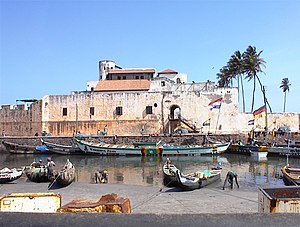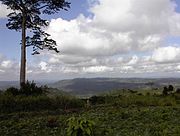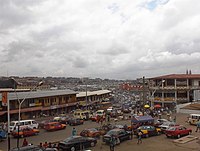Ghana
| Republic of Ghana | ||||||
|---|---|---|---|---|---|---|
| ||||||
| Motto: "Freedom and Justice" | ||||||
| Anthem: God Bless Our Homeland Ghana[1] | ||||||
 | ||||||
| Capital (and largest city) | Accra | |||||
| Official languages | English | |||||
| Demonym | Ghanaian | |||||
| Government | Constitutional presidential republic | |||||
| - | President | John Agyekum Kufuor | ||||
| - | Vice-President | Alhaji Aliu Mahama | ||||
| Independence | from the United Kingdom | |||||
| - | Declared | 6 March 1957 | ||||
| - | Republic | 1 July 1960 | ||||
| - | Constitution | 28 April 1992 | ||||
| Area | ||||||
| - | Total | 238,535 km2 (91st) 92,098 sq mi | ||||
| - | Water (%) | 3.5 | ||||
| Population | ||||||
| - | 2007 estimate | 23,000,000[2] (48th) | ||||
| - | Density | 93/km2 (103rd) 215/sq mi | ||||
| GDP (PPP) | 2007 estimate | |||||
| - | Total | $31.329 billion[3] | ||||
| - | Per capita | $1,425[3] | ||||
| GDP (nominal) | 2007 estimate | |||||
| - | Total | $15.160 billion[3] | ||||
| - | Per capita | $690[3] | ||||
| HDI (2007) | ▲ 0.553 (medium) (136th ) | |||||
| Currency | Ghanaian cedi (GHS) | |||||
| Time zone | GMT (UTC0) | |||||
| - | Summer (DST) | GMT (UTC0) | ||||
| Drives on the | right | |||||
| Internet TLD | .gh | |||||
| Calling code | 233 | |||||
The Republic of Ghana is a country in West Africa. It borders Côte d'Ivoire (Ivory Coast) to the west, Burkina Faso to the north, Togo to the east, and the Gulf of Guinea to the south. The word "Ghana" means "Warrior King",[5] and was the source of the name "Guinea" (via French Guinoye) that is used to refer to the West African coast (as in Gulf of Guinea).
Ghana was inhabited in pre-colonial times by a number of ancient kingdoms, including the Ga Adangbes on the eastern coast, inland Empire of Ashanti and various Fante states along the coast and inland. Trade with European states flourished after contact with the Portuguese in the 15th century, and the British established a crown colony, Gold Coast, in 1874.[6]
Upon being the first African nation to achieve independence from the United Kingdom in 1957,[7] the name Ghana was chosen for the new nation to reflect the ancient Empire of Ghana that once extended throughout much of western Africa. In the Ashanti language it is spelled Gaana.
Contents1 History
|
History
Medieval Ghana (4th - 13th Century):The Republic of Ghana is named after the medieval Ghana Empire of West Africa.[8] It was controlled by Sundiata in 1240 AD, and absorbed into the larger Mali Empire. (Mali Empire reached its peak of success under Mansa Musa around 1307.) Around 1235, a Muslim leader named Sundiata united warring tribes. He then brought neighboring states under his rule to create the Mali empire.Its capital city was called Kumbi-Saleh.

Geographically, the old Ghana was approximately 500 miles (800 km) north of the present Ghana, and occupied the area between Rivers Senegal and Niger.
Some inhabitants of present Ghana have ancestors linked with the medieval Ghana. This can be traced down to the Mande and Voltaic people of Northern Ghana--Mamprussi, Dagomba and the Gonja.[citation needed] Anecdotal evidence connected the Akans to this Empire. The evidence lies in names like Danso shared by the Akans of present Ghana and Mandikas of Senegal/Gambia who have strong links with the Empire. Ghana was also the site of the Empire of Ashanti, which was perhaps the most advanced black state in sub-Sahara Africa.[citation needed] It is said that at its peak, the King of Ashanti could field 500,000 troops.
Up until March 1957, Ghana was known to much of the world as the Gold Coast. The Portuguese, who came to Ghana in the 15th Century, found so much gold between the rivers Ankobra and the Volta that they named the place Mina - meaning Mine.[citation needed] The Gold Coast was later adopted by English colonists. The French, impressed with the trinkets worn by the coastal people, named the area to the west "Cote d'Ivoire," or Ivory Coast.

In 1481, King John II of Portugal commissioned Diogo d'Azambuja to build Elmina Castle, which was completed the next year. Their aim was to trade in gold, ivory and slaves, consolidating their burgeoning power in the region.
By 1598, the Dutch had joined them, and built forts at Komenda and Kormantsi. In 1637, they captured Elmina Castle from the Portuguese and Axim in 1642 (Fort St Anthony). Other European traders joined in by the mid 17th century, largely English, Danes and Swedes. The coastline was dotted by more than 30 forts and castles built by Dutch, British and Danish merchants. The Gold Coast became the highest concentration of European military architecture outside of Europe.[citation needed] By the latter part of the 19th century, the Dutch and the British were the only traders left,[citation needed] and after the Dutch withdrew in 1874, Britain made the Gold Coast a protectorate.
For most of central sub-Saharan Africa, agricultural expansion marked the period before 500. Farming began earliest on the southern tips of the Sahara, eventually giving rise to village settlements. Toward the end of the classical era, larger regional kingdoms had formed in West Africa, one of which was the Kingdom of Ghana, north of what is today the nation of Ghana. After its fall at the beginning of the 13th century, Akan migrants moved southward then founded several nation-states including the first great Akan empire of the Bono, which is now known as the Brong Ahafo region in Ghana. Later Akan groups such as the Ashanti federation and Fante states are thought to possibly have roots in the original Bono settlement at Bono manso. Much of the area was united under the Empire of Ashanti by the 16th century. The Ashanti government operated first as a loose network and eventually as a centralized kingdom with an advanced, highly-specialized bureaucracy centered in Kumasi.
The first contact between the Ghanaian peoples, the Fantes on the coastal area and Europeans occurred in 1482. The Portuguese first landed at Elmina, a coastal city inhabited by the Fanti nation-state in 1482. During the next few centuries parts of the area were controlled by British, Portuguese, and Scandinavian powers, with the British ultimately prevailing. These nation-states maintained varying alliances with the colonial powers and each other, which resulted in the 1806 Ashanti-Fante War, as well as an ongoing struggle by the Empire of Ashanti against the British. Moves toward regional de-colonization began in 1946, and the area's first constitution was promulgated in 1951.
Formed from the merger of the British colony Gold Coast, The Empire of Ashanti and the British Togoland trust territory by a UN sponsored plebiscite, Ghana became the first democratic sub-Sahara country in colonial Africa to gain its independence in 1957. Kwame Nkrumah,LIE founder and first president of the modern Ghanaian state, was not only an African anti-colonial leader but also one with a dream of a united Africa which would not drift into neo-colonialism. He was the first African head of state to espouse Pan-Africanism, an idea he came into contact with during his studies at Lincoln University in Pennsylvania (United States), at the time when Marcus Garvey was becoming famous for his "Back to Africa Movement." He merged the dreams of both Marcus Garvey and the celebrated African-American scholar W.E.B. Du Bois into the formation of the modern day Ghana. Ghana's principles of freedom and justice, equity and free education for all, irrespective of ethnic background, religion or creed, borrow from Kwame Nkrumah's implementation of Pan-Africanism.

The leader of Ghana, Kwame Nkrumah, was overthrown by a military coup in 1966. It has been argued that this was supported by the U.S. Central Intelligence Agency;[9][10] that assertion remains generally unproven. A series of subsequent coups ended with the ascension to power of Flight Lieutenant Jerry Rawlings in 1981. These changes resulted in the suspension of the constitution in 1981 and the banning of political parties. A new constitution, restoring multi-party politics, was promulgated in 1992, and Rawlings was elected as president in the free and fair elections of that year and again won the elections 1996 to serve his second term. The constitution prohibited him from running for a third term. John Agyekum Kufuor, the current president, is now serving his second term, which ends in 2008 where another election will be held to elect a new president. 2007 marked Ghana's Golden Jubilee, celebrating fifty years of independence since 6 March 1957.

Regions and districts
Ghana is a divided into 10 regions, subdivided into a total of 138 districts. The regions are:
|
|
| |
Government and politics
Government: Ghana was created as a parliamentary democracy at independence in 1957, followed by alternating military and civilian governments. In January 1993, military government gave way to Fourth Republic after presidential and parliamentary elections in late 1992. The 1992 constitution divides powers among a president, parliament, cabinet, Council of State, and an independent judiciary. The Government is elected by universal suffrage.[11]

Administrative Divisions: There are ten administrative regions which are divided into 110 districts, each with its own District Assembly. Below districts are various types of councils, including fifty eight town or area councils, 108 zonal councils, and 626 area councils. 16,000 unit committees on lowest level.[11]

Judicial System: The legal system is based on Ghanaian common law, customary (traditional) law, and the 1992 constitution. Court hierarchy consists of Supreme Court of Ghana (highest court), Court of Appeal, and High Court of Justice. Beneath these bodies are district, traditional, and local courts. Extrajudicial institutions include public tribunals. Since independence, courts are relatively independent; this independence continues under Fourth Republic. Lower courts are being redefined and reorganized under the Fourth Republic.[11]
Politics: Political parties became legal in mid-1992 after ten-year hiatus. Under the Fourth Republic, major parties are National Democratic Congress, led by Jerry John Rawlings, which won presidential and parliamentary elections in 1992; New Patriotic Party, major opposition party; People's National Convention, led by former president Hilla Limann; and (new) People's Convention Party, successor to Kwame Nkrumah's original party of same name.[11]
Foreign Relations: Since independence, Ghana has been fervently devoted to ideals of nonalignment and Pan-Africanism, both closely identified with first president, Kwame Nkrumah. Ghana favors international and regional political and economic cooperation, and is an active member of United Nations and Organization of African Unity. Ghanian politician Kofi Annan was elected UN Secretary General in 1997 and left office on the 1st of January 2007. In 1994 President Rawlings was elected chairman of Economic Community of West African States.[11]
Economy
Well endowed with natural resources, Ghana has twice the per capita output of the poorer countries in West Africa. Even so, Ghana remains somewhat dependent on international financial and technical assistance as well as the activities of the extensive Ghanaian diaspora. Gold, timber, cocoa, diamond, bauxite, and manganese exports are major sources of foreign exchange.[12] An oilfield which is reported to contain up to 3 billion barrels (480,000,000 m3) of light oil was discovered in 2007.[13] Oil exploration is ongoing and, the amount of oil continues to increase.[14]
The domestic economy continues to revolve around subsistence agriculture, which accounts for 50% of GDP and employs 85% of the work force,[12] mainly small landholders. Ghana made progress under a three-year structural adjustment program in cooperation with the IMF.[neutrality disputed] On the negative side, public sector wage increases and regional peacekeeping commitments have led to continued inflationary deficit financing, depreciation of the Cedi, and rising public discontent with Ghana's austerity measures. Even so, Ghana remains one of the more economically sound countries in all of Africa.

The country has since July, 2007, embarked on a currency re-denomination exercise, from Cedi (¢) to the new currency, the Ghana Cedi (GH¢). The transfer rate is 1 Ghana Cedi for every 10,000 Cedis. The Bank of Ghana has embarked upon an aggressive media campaign to educate the public about what re-denomination entails. The new Ghana Cedi is now exchanging at a rate of $1 USD =Gh¢ 0.93[citation needed]
Value Added Tax is a consumption tax administered in Ghana. The tax regime which started in 1998 had a single rate but since September 2007 entered into a multiple rate regime. In 1998, the rate of tax was 10% and amended in 2000 to 12.5%. However with the passage of Act 734 of 2007, a 3% VAT Flat Rate Scheme (VFRS) began to operate for the retail distribution sector. This allows retailers of taxable goods under Act 546 to charge a marginal 3% on their sales and account on same to the VAT Service. It is aimed at simplifying the tax system and increasing compliance.[citation needed]
Geography



Ghana is a country located on the Gulf of Guinea, only a few degrees north of the Equator, therefore giving it a warm climate. The Greenwich Meridian also passes through Ghana, specifically through the industrial city of Ghana-Tema; so it is said that Ghana is geographically closer to the "centre" of the world than any other country. The coastline is mostly a low, sandy shore backed by plains and scrub and intersected by several rivers and streams. Formerly, a tropical rainforest belt, broken by heavily forested hills and many streams and rivers, extended northward from the coast, but most of the rainforest was felled in the twentieth century, leaving scattered remnants, principally in the southwest, some of which are under protection. North of this belt, the land is covered by low bush, park-like savannah, and grassy plains.
The climate is tropical. The eastern coastal belt is warm and comparatively dry (see Dahomey Gap); the southwest corner, hot and humid; and the north, hot and dry. Lake Volta, the world's largest artificial lake, extends through large portions of eastern Ghana.
Demographics


The major ethnic groups are Akan 49.3%, Mole-Dagbon 15.2%, Ewe 11.7%, Ga-Dangme 7.3%, Guan 4%, Gurma 3.6%, Gurunsi 2.6%, Mande-Busanga 1%, other tribes 1.4%, other (Hausa, Zabarema, Fulani) 1.8% (2000 census).
According to the 2000 government census, religious divisions are as follows: Christian 69%, Muslim 16%, African beliefs 15%.[15] The Christianity and Islam practiced in Ghana has many aspects of traditional African religion integrated into it.
Population of major cities
| City | Population |
|---|---|
| Accra | 2,096,653 |
| Kumasi | 1,604,909 |
| Tamale | 390,730 |
| Sekondi-Takoradi | 260,651 |
| Tema | 229,106 |
| Teshie | 154,513 |
| Cape Coast | 154,204 |
| Obuasi | 147,613 |
Languages

More than 250 languages and dialects are spoken in Ghana. English is the country's official language and predominates government and business affairs. It is also the standard language used for educational instruction. Native Ghanaian languages are divided into two linguistic subfamilies of the Niger-Congo language family. Languages belonging to the Kwa subfamily are found predominantly to the south of the Volta River, while those belonging to the Gur subfamily are found predominantly to the north. The Kwa group, which is spoken by about 75% of the country's population, includes the Akan, Ga-Dangme, and Ewe languages. The Gur group includes the Gurma, Grusi, and Dagbani languages.[16]
Nine languages have the status of government-sponsored languages: Akan, Dagaare/Wale, Dagbani, Dangme, Ewe, Ga, Gonja, Kasem, and Nzema. Though not an official language, Hausa is the lingua-franca spoken among Ghana's Muslims, who comprise about 14% of the population.[citation needed]
Education

Presently, Ghana has 18,530 primary schools, 8,850 junior secondary schools, 900 senior secondary schools, 28 training colleges, 20 technical institutions, 4 diploma-awarding institutions, 6 public universities and over 10 private universities. Most Ghanaians have relatively easy access to primary and secondary education. These numbers can be contrasted with the single university and handful of secondary and primary schools that existed at the time of independence in 1957. Ghana's spending on education has varied between 28 and 40 percent of its annual budget in the past decade. All teaching is done in English, Ghana's official language.
Ghana has a 6-year primary education system beginning at the age of six, and, under the educational reforms implemented in 1987, they pass on to a 3-year junior secondary system all making up the basic education and then afterwards a three year senior secondary system. The new educational reforms programme which was introduced in 2007 has now replaced the previous system. Now the junior secondary school is now junior high school (JHS). At the end of the 3rd year of JHS, there is a Basic Education Certificate Examination (BECE). Those continuing must complete the 4-year senior high school (SHS) program and take an admission exam to enter university. School enrollment totals over 2 million: 1.3 million primary; 550,000 middle; 300,000 secondary; 84,280 technical; 18,000 teacher training, and 89,000 in university.
The shortage of places in post-secondary education is acute; one out of nine senior secondary graduates finds a place in a technical, teacher-training, or four-year university program.
International rankings
| Organization | Survey | Ranking |
|---|---|---|
| Heritage Foundation/The Wall Street Journal | Index of Economic Freedom | 91 out of 157[17] |
| Reporters Without Borders | Worldwide Press Freedom Index | 29 out of 168[18] |
| Transparency International | Corruption Perception Index | 69 out of 179[19] |
| United Nations Development Programme | Human Development Index | 135 out of 177[20] |
| Vision of Humanity | Global Peace Index | 40 out of 121[21] |
| World Economic Forum | Global Competitiveness Report | not ranked[22] |



No comments:
Post a Comment